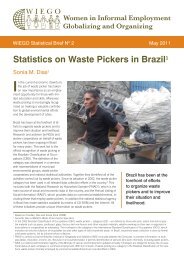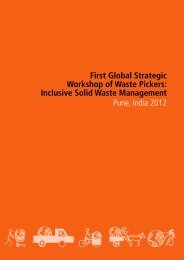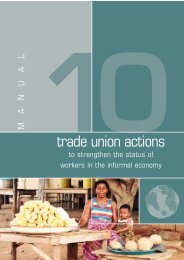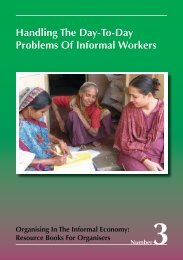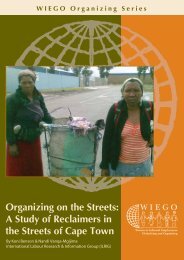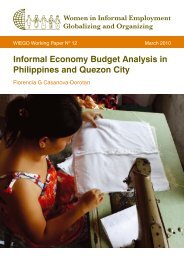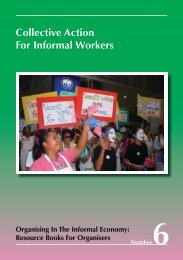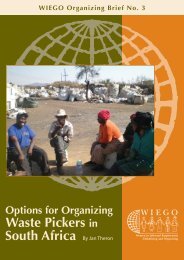Statistics on Informal Employment in South Africa - WIEGO
Statistics on Informal Employment in South Africa - WIEGO
Statistics on Informal Employment in South Africa - WIEGO
You also want an ePaper? Increase the reach of your titles
YUMPU automatically turns print PDFs into web optimized ePapers that Google loves.
<strong>Employment</strong> rates are higher <strong>in</strong> metros than <strong>in</strong> n<strong>on</strong>-metro areas. Thus 56 percent of work<strong>in</strong>g age men and 39 per cent of women <strong>in</strong> metro areas are employed.In additi<strong>on</strong> to differences <strong>in</strong> employment rates, there are differences <strong>in</strong> the typeof work that women and men do. A large majority (83 per cent for men and 85per cent for women) of employed people work as employees. However, 8 percent of men are employers compared to <strong>on</strong>ly 2 per cent of women, while a further8 per cent of men are own-account workers who do not have any regularemployees, compared to 11 per cent of women. This leaves 1 per cent of bothwomen and men who work as unpaid family workers.About 5 per cent of all employed people are recorded by the QLFS as work<strong>in</strong>g<strong>in</strong> agriculture. This percentage probably does not <strong>in</strong>clude all people who work<strong>in</strong> agriculture, as the QLFS does not capture subsistence work. The patterns <strong>in</strong>the type of work for women and men change very little if we exclude agriculture.If we look <strong>on</strong>ly at metro areas, 88 per cent of employed women and 83 per cent ofemployed men are employees, and 8 per cent of both women and men are own-accountworkers. The differences <strong>in</strong> the percentages of women and men who are employeesare balanced by the percentages who are employers – 3 per cent of womenand 8 per cent of men. Less than 1 per cent of employed people <strong>in</strong> metro areas work<strong>in</strong> agriculture, so aga<strong>in</strong> the patterns do not change if we exclude agriculture.<strong>Informal</strong> Work<str<strong>on</strong>g>Statistics</str<strong>on</strong>g> <strong>South</strong> <strong>Africa</strong>’s def<strong>in</strong>iti<strong>on</strong> of <strong>in</strong>formal employment <strong>in</strong>cludes all workers <strong>in</strong>the <strong>in</strong>formal sector. Employers, own-account workers and unpaid family workersare def<strong>in</strong>ed as be<strong>in</strong>g <strong>in</strong> the <strong>in</strong>formal sector if the bus<strong>in</strong>ess for which they work isnot registered for value added tax (VAT) or <strong>in</strong>come tax. Employees are def<strong>in</strong>ed asbe<strong>in</strong>g <strong>in</strong> the <strong>in</strong>formal sector if their employer does not deduct <strong>in</strong>come tax fromtheir pay and if the bus<strong>in</strong>ess <strong>in</strong> which they work has fewer than five employees.<strong>Informal</strong> employment also <strong>in</strong>cludes employees <strong>in</strong> the formal sector and privatehouseholds whose employers do not c<strong>on</strong>tribute to their pensi<strong>on</strong> or medical<strong>in</strong>surance, and who also do not have a written c<strong>on</strong>tract of employment. <str<strong>on</strong>g>Statistics</str<strong>on</strong>g><strong>South</strong> <strong>Africa</strong>’s guide to the QLFS says that these rules are applied to allemployees. However, the dataset has all domestic workers (see below) classifiedas <strong>in</strong>formal workers, even though some have employers who c<strong>on</strong>tribute totheir pensi<strong>on</strong> or medical <strong>in</strong>surance or have written c<strong>on</strong>tracts of employment.A third (33 per cent) of all employed people are <strong>in</strong>formal workers – 39 percent of employed women and 29 per cent of employed men. Two-thirds (67per cent) of the <strong>in</strong>formal workers are employees, 25 per cent are own-accountworkers, 5 per cent are employers, and 3 per cent are unpaid family workers.<strong>Informal</strong> work is less comm<strong>on</strong> <strong>in</strong> metro than <strong>in</strong> other areas. In metro areas, about<strong>on</strong>e quarter (26 per cent) of employed people are <strong>in</strong>formal workers – 29 per centof employed women and 23 per cent of employed men. In both metro areas andthe country as a whole, women are thus more likely than men to be <strong>in</strong>formal workers.Similar to the pattern for the country as a whole, <strong>in</strong> metro areas two-thirds (66per cent) of the <strong>in</strong>formal workers are employees, 24 per cent are own-accountworkers, 6 per cent are employers, and 3 per cent are unpaid family workers.The biggest sectors of <strong>in</strong>formal work <strong>in</strong> metropolitan areas are trade and privatehouseholds. Each of these sectors accounts for 29 per cent of all workers. The percentageof <strong>in</strong>formal workers <strong>in</strong> trade is similar for women (27 per cent) and men (31per cent). However, <strong>on</strong>ly 10 per cent of men <strong>in</strong>formal workers <strong>in</strong> the metros are <strong>in</strong>private households compared to 50 per cent of women <strong>in</strong>formal workers – 27 percent of women and 31 per cent of men. The gender pattern is reversed for the thirdbiggest sector, which is c<strong>on</strong>structi<strong>on</strong>. About 12 per cent of all <strong>in</strong>formal workers are <strong>in</strong>c<strong>on</strong>structi<strong>on</strong>, but the percentage is 21 per cent for men and <strong>on</strong>ly 2 per cent for women.Manufactur<strong>in</strong>g (8 per cent) and services other than private households (7 percent) are the fourth and fifth biggest sectors of metropolitan <strong>in</strong>formal employment.A third (33 per cent) ofall employed peopleare <strong>in</strong>formal workers–39 per cent of employedwomen and 29per cent of employedmen. Two-thirds (67 percent) of the <strong>in</strong>formalworkers are employees,25 per cent are ownaccountworkers, 5 percent are employers and3 per cent are unpaidfamily workers.If we compare metros <strong>in</strong> the different prov<strong>in</strong>ces, there are <strong>on</strong>ly small differences <strong>in</strong>the <strong>in</strong>dustry sectoral profile of <strong>in</strong>formal workers. Cape Town has a higher proporti<strong>on</strong>of <strong>in</strong>formal workers <strong>in</strong> c<strong>on</strong>structi<strong>on</strong> (17 per cent), manufactur<strong>in</strong>g (11 per cent) andn<strong>on</strong>-household services (10 per cent) than the other metros, and the lowest proporti<strong>on</strong>(25 per cent) <strong>in</strong> trade. EThekw<strong>in</strong>i has the highest proporti<strong>on</strong> <strong>in</strong> agriculture (3 percent), and Nels<strong>on</strong> Mandela has the highest proporti<strong>on</strong> <strong>in</strong> transport (11 per cent).2 I <strong>WIEGO</strong> Statistical Brief N o 3
Domestic Workers, Home-based Workers,Street Traders, and Waste Pickers<strong>WIEGO</strong> and the organizati<strong>on</strong>s with which it works are especially <strong>in</strong>terested<strong>in</strong> four groups of <strong>in</strong>formal workers: domestic workers, home-based workers,street traders, and waste pickers. These categories of workers are often notcaptured well <strong>in</strong> surveys. One reas<strong>on</strong> is that some of these workers are notrecorded at all. For example, household resp<strong>on</strong>dents may not give <strong>in</strong>formati<strong>on</strong><strong>on</strong> domestic workers who work for them, and waste pickers may be liv<strong>in</strong>g<strong>on</strong> the street rather than <strong>in</strong> dwell<strong>in</strong>gs visited dur<strong>in</strong>g the survey. And the workthat home workers do may not be c<strong>on</strong>sidered “proper” work by the report<strong>in</strong>ghousehold member.We classify as domestic workers all those with occupati<strong>on</strong> code 9131. This isa narrow def<strong>in</strong>iti<strong>on</strong> of domestic workers that <strong>in</strong>cludes <strong>on</strong>ly those classified asunskilled general domestic workers. It excludes, for example, about 72,000housekeepers and childcare workers employed by private households, most ofwhom are <strong>in</strong>formal workers.Even with the narrow def<strong>in</strong>iti<strong>on</strong>, the QLFS records more than 900,000 domesticworkers. As noted above, <str<strong>on</strong>g>Statistics</str<strong>on</strong>g> <strong>South</strong> <strong>Africa</strong>’s dataset categorizes allthese workers as <strong>in</strong>formal workers. Analysis of the dataset shows that 22 percent of these domestic workers should be classified as formal workers if thedef<strong>in</strong>iti<strong>on</strong>al rules are followed because their employer c<strong>on</strong>tributes to medical<strong>in</strong>surance or pensi<strong>on</strong> or they have a written c<strong>on</strong>tract. Almost all (96 per cent)the domestic workers are women.Domestic workers account for 20 per cent of all <strong>in</strong>formal workers <strong>in</strong> n<strong>on</strong>-metropolitanareas and 23 per cent of all <strong>in</strong>formal workers <strong>in</strong> the metros. Domestic workersaccount for nearly a third (31 per cent) of all <strong>in</strong>formal workers <strong>in</strong> Nels<strong>on</strong> Mandela.In c<strong>on</strong>trast, <strong>in</strong> Cape Town they account for 18 per cent of all <strong>in</strong>formal workers.We classify <strong>in</strong>formal workers as street traders if they give their occupati<strong>on</strong> asstreet vendors of food or n<strong>on</strong>-food products (occupati<strong>on</strong> codes 9111 and 9112respectively). More than 530,000 street traders are recorded <strong>in</strong> the QLFS, ofwhom 70 per cent are women. Only a third (33 per cent) of these workers are<strong>in</strong> metro areas. Almost all (97 per cent) the street traders are <strong>in</strong>formal workers.The QLFS does not <strong>in</strong>clude a questi<strong>on</strong> about where people work. This makes itimpossible to dist<strong>in</strong>guish home-based workers.<str<strong>on</strong>g>Statistics</str<strong>on</strong>g> <strong>South</strong> <strong>Africa</strong> has an occupati<strong>on</strong> code – 9161 – for garbage collectors. However,the QLFS c<strong>on</strong>ducted <strong>in</strong> the sec<strong>on</strong>d quarter of 2010 does not record any workersas hav<strong>in</strong>g this occupati<strong>on</strong> code. Even if there were workers with this classificati<strong>on</strong>,we could not simply def<strong>in</strong>e them as waste pickers. We would need to restrict ourdef<strong>in</strong>iti<strong>on</strong> further, for example by <strong>in</strong>clud<strong>in</strong>g <strong>on</strong>ly those who were self-employed, <strong>in</strong>order to exclude workers such as garbage collectors employed by municipalities. Asnoted above, <strong>on</strong>e reas<strong>on</strong> for n<strong>on</strong>-record<strong>in</strong>g of waste pickers may be that the surveyis household-based, and many waste pickers may not live <strong>in</strong> the type of dwell<strong>in</strong>g thatis visited <strong>in</strong> the survey. This does not expla<strong>in</strong> why the QLFS did not capture municipalgarbage collectors. Perhaps they did not provide detailed descripti<strong>on</strong>s of their job.More than 530,000street traders arerecorded <strong>in</strong> the QuarterlyLabour Survey, of which70 per cent are women.Only a third (33 per cent)of these workers are <strong>in</strong>metro areas.Earn<strong>in</strong>gsWhen <str<strong>on</strong>g>Statistics</str<strong>on</strong>g> <strong>South</strong> <strong>Africa</strong> <strong>in</strong>troduced the QLFS <strong>in</strong> 2008, they dropped thequesti<strong>on</strong>s <strong>on</strong> earn<strong>in</strong>gs that were <strong>in</strong> the previous Labour Force Survey. <str<strong>on</strong>g>Statistics</str<strong>on</strong>g><strong>South</strong> <strong>Africa</strong> re<strong>in</strong>troduced the earn<strong>in</strong>gs questi<strong>on</strong>s <strong>in</strong> 2009, but has not yet releasedthe earn<strong>in</strong>gs data to the public.About wiego: Women <strong>in</strong> <strong>Informal</strong> <strong>Employment</strong>: Globaliz<strong>in</strong>g and Organiz<strong>in</strong>g is a global research-policy-acti<strong>on</strong> network that seeksto improve the status of the work<strong>in</strong>g poor, especially women, <strong>in</strong> the <strong>in</strong>formal ec<strong>on</strong>omy. <strong>WIEGO</strong> draws its membership frommembership-based organizati<strong>on</strong>s of <strong>in</strong>formal workers, researchers and statisticians work<strong>in</strong>g <strong>on</strong> the <strong>in</strong>formal ec<strong>on</strong>omy. For more<strong>in</strong>formati<strong>on</strong> see www.wiego.org.About Inclusive Cities: Launched <strong>in</strong> 2008, the Inclusive Cities project aims to strengthen membership-based organizati<strong>on</strong>s (MBOs) ofthe work<strong>in</strong>g poor <strong>in</strong> the areas of organiz<strong>in</strong>g, policy analysis and advocacy, <strong>in</strong> order to ensure that urban <strong>in</strong>formal workers have the toolsnecessary to make themselves heard with<strong>in</strong> urban plann<strong>in</strong>g processes. Inclusive Cities is a collaborati<strong>on</strong> between MBOs of the work<strong>in</strong>gpoor, <strong>in</strong>ternati<strong>on</strong>al alliances of MBOs and those support<strong>in</strong>g the work of MBOs. For more <strong>in</strong>formati<strong>on</strong> see www.<strong>in</strong>clusivecities.org.3 I <strong>WIEGO</strong> Statistical Brief N o 3




